EFSA 2009 Annual report on pesticide residues - PAN Europe
EFSA 2009 Annual report on pesticide residues - PAN Europe
EFSA 2009 Annual report on pesticide residues - PAN Europe
Create successful ePaper yourself
Turn your PDF publications into a flip-book with our unique Google optimized e-Paper software.
<str<strong>on</strong>g>2009</str<strong>on</strong>g> EU Report <strong>on</strong> Pesticide Residues<br />
exceedances c<strong>on</strong>cerned samples of infant formulae with residue levels of captan exceeding the legal<br />
limits. Other MRL exceedances in baby food/infant formulae were <str<strong>on</strong>g>report</str<strong>on</strong>g>ed for pirimiphos-methyl,<br />
imazalil, chlorpropham, thiabendazole and diazin<strong>on</strong>.<br />
At EU level, no specific MRLs for organic products are in place; thus, the MRLs established for<br />
c<strong>on</strong>venti<strong>on</strong>ally produced products apply also to this food category. In <str<strong>on</strong>g>2009</str<strong>on</strong>g>, a total of 3,090 samples<br />
of organic origin were taken by a total of 25 countries, which corresp<strong>on</strong>ds to 5% of all surveillance<br />
samples taken in the <str<strong>on</strong>g>report</str<strong>on</strong>g>ing countries. For fruit and nuts grown organically, a lower rate of MRL<br />
exceedances (0.4%) was found in comparis<strong>on</strong> to c<strong>on</strong>venti<strong>on</strong>ally grown fruit and nuts (2.7%), for<br />
vegetables the MRL exceedances of the samples were 0.5% and 3.4% respectively for organically and<br />
c<strong>on</strong>venti<strong>on</strong>ally grown crops. The following substances were found in organic samples, even if their<br />
use was not allowed in organic producti<strong>on</strong>: chlormequat, fenbutatin oxide, MCPA and MCPB,<br />
mepiquat, methabenzthiazur<strong>on</strong> and propamocarb. Also <strong>residues</strong> of CS 2 - which is an indicator for the<br />
presence of <strong>pesticide</strong>s bel<strong>on</strong>ging to the group of the dithiocarbamates - were found. However, since<br />
some crops c<strong>on</strong>tain natural compounds which also release CS 2 during the chemical analysis the results<br />
cannot prove bey<strong>on</strong>d doubt that dithiocarbamate <strong>pesticide</strong>s were used.<br />
In <str<strong>on</strong>g>2009</str<strong>on</strong>g>, multiple <strong>residues</strong> of two or more <strong>pesticide</strong>s in the same sample were found in 25.1% of the<br />
analysed surveillance samples. Important commodities with high frequencies of multiple <strong>residues</strong><br />
were citrus fruit (56.6%), table and wine grapes (55.5%) and strawberries (53.8%). 299 unprocessed<br />
surveillance samples were found to exceed two or more MRLs. The commodity with the highest<br />
number of samples with multiple MRL exceedances was peppers (46 out of 1704 samples exceeded<br />
the MRL for two or more <strong>pesticide</strong>s).<br />
The results of the EU-coordinated m<strong>on</strong>itoring programme were used to perform dietary exposure<br />
assessments. In <str<strong>on</strong>g>2009</str<strong>on</strong>g>, the results of the c<strong>on</strong>trol activities were <str<strong>on</strong>g>report</str<strong>on</strong>g>ed with a new <str<strong>on</strong>g>report</str<strong>on</strong>g>ing format<br />
which allowed improving the accuracy of the c<strong>on</strong>sumer exposure calculati<strong>on</strong>s in comparis<strong>on</strong> to the<br />
previous year, in particular for the calculati<strong>on</strong> of the l<strong>on</strong>g-term c<strong>on</strong>sumer exposure.<br />
The chr<strong>on</strong>ic (l<strong>on</strong>g-term) exposure assessment was based <strong>on</strong> the residue findings for the food<br />
commodities which are the major c<strong>on</strong>stituents of the human diet. <str<strong>on</strong>g>EFSA</str<strong>on</strong>g> c<strong>on</strong>cluded that <strong>residues</strong> found<br />
<strong>on</strong> these food commodities do not raise health c<strong>on</strong>cerns if c<strong>on</strong>sumed over a l<strong>on</strong>g period.<br />
The assessment of the acute (short-term) c<strong>on</strong>sumer exposure was performed for the ten food<br />
commodities which were analysed under the <str<strong>on</strong>g>2009</str<strong>on</strong>g> EU co-ordinated m<strong>on</strong>itoring programme. The<br />
assessment was based <strong>on</strong> worst-case scenarios, supposing the c<strong>on</strong>sumpti<strong>on</strong> of a large porti<strong>on</strong> of the<br />
food item under c<strong>on</strong>siderati<strong>on</strong> c<strong>on</strong>taining the highest residue measured in the coordinated programme.<br />
In order to accommodate for a possible n<strong>on</strong>-homogeneous distributi<strong>on</strong> of <strong>residues</strong> in an analysed food<br />
lot 7 an additi<strong>on</strong>al variability factor was introduced in the calculati<strong>on</strong>. Assuming a coincidence of these<br />
events (high food c<strong>on</strong>sumpti<strong>on</strong>, high residue c<strong>on</strong>centrati<strong>on</strong> and inhomogeneous residue distributi<strong>on</strong> in<br />
a lot), out of 10,553 samples a potential c<strong>on</strong>sumer risk could not be excluded for a total of 77 samples<br />
c<strong>on</strong>cerning 32 <strong>pesticide</strong>/commodity combinati<strong>on</strong>s. Taking into account the frequency of the<br />
occurrence of the critical <strong>residues</strong> (in less than 0.1% of the samples tested for the given <strong>pesticide</strong>/crop<br />
combinati<strong>on</strong>s) and the frequency of extreme c<strong>on</strong>sumpti<strong>on</strong> events, the events leading to a potential risk<br />
were c<strong>on</strong>sidered very unlikely. The highest potential exceedances of the toxicological reference value<br />
were calculated for carbofuran <strong>residues</strong> in peppers (14,275% of the ARfD), oxamyl <strong>residues</strong> in<br />
peppers (9,510% of the ARfD), m<strong>on</strong>ocrotophos <strong>residues</strong> in peppers (7,557% of the ARfD),<br />
7 Acoording to the <strong>Europe</strong>an legislati<strong>on</strong> <strong>on</strong> the official c<strong>on</strong>trol of <strong>pesticide</strong> <strong>residues</strong> an analytical sample is composed by at<br />
least five food units, e.g. five cucumbers, ten apples.<br />
<str<strong>on</strong>g>EFSA</str<strong>on</strong>g> Journal 2011;9(11):2430 4


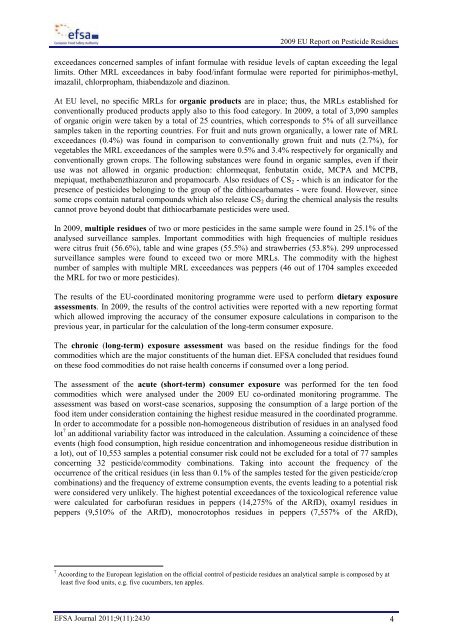
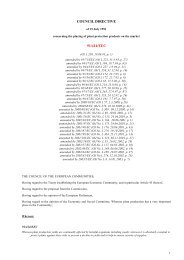
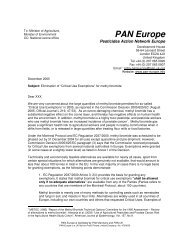
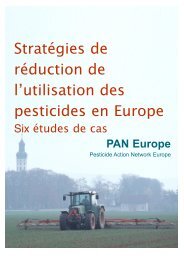
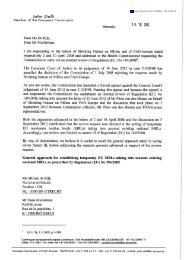
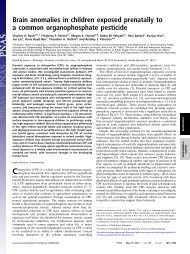
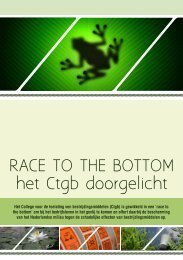
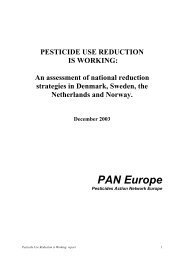
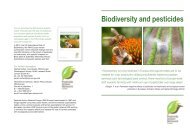
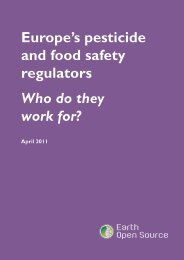
![Complete article [PDF 56KB] - PAN Europe](https://img.yumpu.com/41450983/1/190x245/complete-article-pdf-56kb-pan-europe.jpg?quality=85)
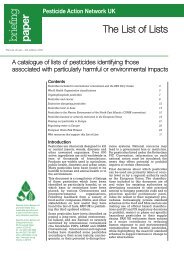

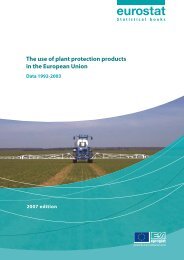
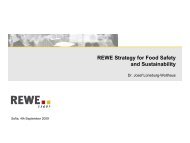
![Complete article [PDF 40KB] - PAN Europe](https://img.yumpu.com/36504990/1/184x260/complete-article-pdf-40kb-pan-europe.jpg?quality=85)